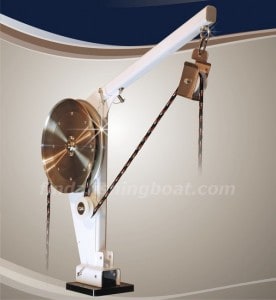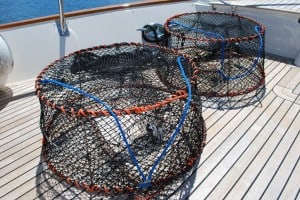Friday, June 3 – Departure day. No glitches this time, no broken bones, no unexpected delays.
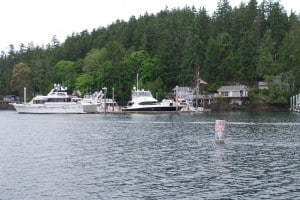
Last weekend we had our shakedown cruise to check out all systems on Flying Colours. We spent the 3-day Memorial Day weekend at the Seattle Yacht Club outstation at Friday Harbor on San Juan Island. We were on an end tie, just across the dock from the Riviera with the black hull. The small building to the right of the flag pole is the clubroom for members, with laundry and showers. The full-time outstation manager lives in the small house to the left of the flag pole. It’s a relaxing ¾ mile walk to town for groceries and restaurants.
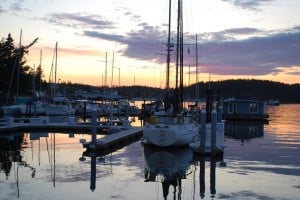
The sunset on Friday night was wonderful – well worth it to have a glass of wine in the fly bridge as it got better and better.
We had hoped to be away in the early morning, as the outgoing tide would be with us, but the inevitable extra things to do in loading an entire summer’s glimp aboard always take more time than planned for. After loading bicycles aboard, stowing the gear that we brought with us from home, and getting Gator settled aboard, we slipped the lines on our dock at 1:10PM. Kap backed us out into the fairway and pivoted us 90º, while I raised the antenna arch with our nifty new remote control, then raised the two 16’ tall VHF radio antennas on the side of the fly bridge.
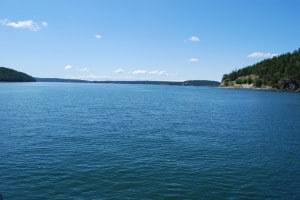
The weather was spectacularly nice as we crossed Rosario Strait and headed into Thatcher Pass. This is by far the best weather day we’ve had so far in 2011 – let’s hope it’s a harbinger of the summer to come. We were making almost 10 knots on our way to Sidney, B.C. from Anacortes.
(By the way, if you want to see our route so far, click on the link in the upper right corner that says Current Location. This brings up a Google Map that shows SPOT position reports. The SPOT is a wonderful little GPS gadget that sends a location signal via satellite to this web site.
You can also enlarge any photo by clicking your cursor on it.)
It was a gorgeous day for cruising – one of the first we’ve had so far this year – and it almost felt like summer might finally be here. The sky was blue, with less than 1/10th cloud cover, moderate winds – and warm enough that I wore shorts for the first time this year. Right up until yesterday, we’ve had rain and overcast skies almost every day for weeks and weeks – and today, it’s glorious! What a day to leave for the summer on Flying Colours!
Interestingly, most of our “recent summer cruise project” time has been spent on paraphernalia for prawning. After last year’s poor showing as hunter gatherers on Flying Colours (a total of one prawn pulled up), we decided to get serious about this.
Unlike crabs, who’s habitat is typically in 30’ of water, prawns are mostly found at 300-350’, requiring considerably more of everything – equipment, brute force, and skill in locating them.
Over the winter, we purchased an Ace Line Hauler and had it fitted to our dinghy – no more of the drudgery of hauling up by hand a pair of 10 lb traps full of prawns, with 20+ lbs of weights tied to them. A month (or so) ago, we drove to Delta B.C., just across the Canadian border from Bellingham, and purchased two commercial prawn traps from a company that supplies them by the tens of thousands to local commercial prawners. Then we started asking around to anyone who would listen. How far apart should we “gang” our two traps? How much leaded line should we use to ensure that our extra line (for tidal differences) stays below surface and doesn’t foul anyone’s prop? How much weight should we use on the traps to ensure they don’t skip across the bottom? What kind of bait to use?
Last weekend, we made our shakedown cruise over the 3-day Memorial Day holiday, slipping across to the Seattle Yacht Club outstation at Friday Harbor on San Juan Island. There, we ran into a couple that we’d met in Port McNeill two years ago – Richard and Carol Larsen aboard their 42’ Uniflite powerboat, SUNTOUR – and after listening to all of our questions, Richard set about overnight to make up a complete trap line for us that matched what he uses. The benefit of his system is, it uses a very thin line – too thin to handle by hand, but will work well with our prawn trap puller – and stacks into about 5″ in the bottom of a small bucket when it’s being brought on board in the dinghy.
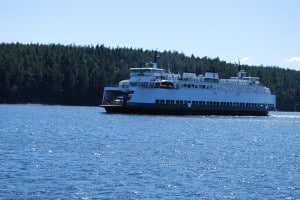
On our route from Anacortes to the Friday Harbor area we always see at least two, sometimes three, Washington State super ferries. They’re such magnificent-looking craft that I almost always step outside to grab a photo. This time, about two minutes after snapping this photo, a text message came in on my cell phone – “I looked out the ferry window and there goes Flying Colours”. It was from Steve and Andrea Clark, our good friends who own a Fleming 55 (COUVERDEN) just like Flying Colours, and who we were meeting up with in Sidney. After hauling out last week for bottom paint, they’re spending some of the weekend down in Seattle.
Today, our 4+ hour cruise takes us across the border to Canada, for the first of several nights that we’d spend in Sidney. This has become our favorite provisioning station, where we can stock up on fresh fruits and vegetables, load all the Happy Hour libations we’ll need for the summer, plus hit a few of our favorite restaurants. Several weeks ago I put in our wine order at The Local Liquor Store in Ganges, and if we don’t meet up with them for a delivery to us in Sidney, I’ll drive up there on the weekend to pick it up. I’m hoping I don’t have to, since with the ferry across from the tip of Saanich Peninsula to Fulford on Saltspring Island, it takes the better part of a day to make the trip.
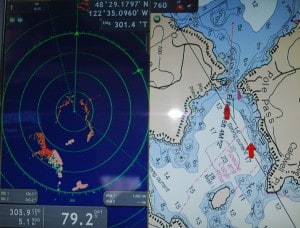
Our Nobeltec chart plotter screen shows us just before entering Pole Pass that separates one of the southern fingers of Orcas Island from Crane Island.
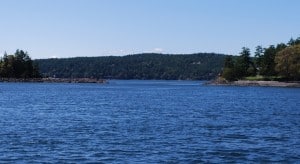
Pole Pass from our vantage point as we approached at low tide. Today was a -2 spring tide, making Pole Pass even narrower than usual.
This year, we broke our 4-year tradition by not stopping at Roche Harbor for one or more nights before entering Canada. Our primary reason has been to have one last dinner at the resort’s McMillans Restaurant, where they had a wonderful 12-garlic chicken dish on the menu that Kap really liked (plus a good steak for me, and a very good wine selection). They recently took it off the menu, and when we asked about it, our waitperson said it was the most popular dish on their menu, but was dropped “because the chef got tired of preparing it”. I guess the chef is more important than customers.
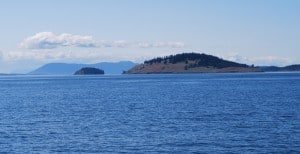
Directly north of Roche Harbor on San Juan Island is the privately-owned Spieden Island – one of the more unusual islands in the group, with its south-facing slopes barren of trees and grass covered, and its north-facing slopes heavily wooded. Several decades ago, the island’s owner attempted to make it into a big game hunting preserve, but this was abandoned from fears that bullets could carry across to the heavily populated areas on San Juan Island. The mountains in the background are on Vancouver Island, north of Victoria.
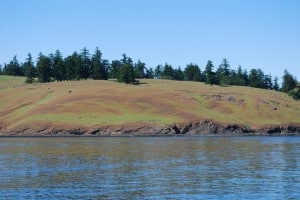
The island looks pretty barren as we cruise by it, but we always train our binoculars along the hillside to see extensive herds of wild animals grazing on the lush grasses.
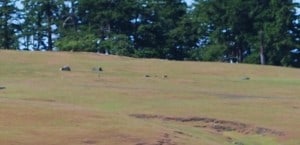
If you didn’t know better, you’d say the island was deserted – but it isn’t. In this zoom-in of the photo, you can see Sika deer (also known as the Spotted Deer or the Japanese Deer), brought to the island in the 1970s for big game hunting. The island also has quite a few Mouflon sheep.
As we wound our way through the various channels and passages of the San Juan Islands, a fairly strong wind came up, and Kap was a bit worried about heavy wind waves building up in Haro Strait as we crossed from Roche Harbor to Sidney. When we got there, though, it was smooth as glass and hardly any wind.
At 4:40 our GPS indicated we were crossing the international border between the U.S. and Canada. With a file containing our boat papers in hand, plus our passports, I called the 800 Nexus number to report our entry to Canada. This is our 7th crossing by boat into Canada since we started cruising, first on Cosmo Place, and now on Flying Colours. Nevertheless, the anxiety and unknown of what the Customs person on the other end of the line will ask, and whether we have declared everything we should, is always uppermost in my mind.
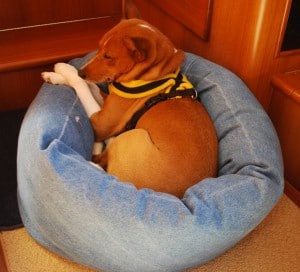
Our plan this summer was to leave Gator, Raz, and ZuZu at boarding facilities – with the monthly flights home that we’ve planned, it’s impossible to have them aboard. In the end, we decided to bring Gator along for the first month, and we’ll fly south with him at the end of June for our first trip home.
This time was a bit more so, as I’d recently read that Canada has relaxed their restrictions on meat and meat products that can be brought across, and since I haven’t yet been able to locate the quality of beef that I like, I’d brought a dozen each of specially-cut prime NY steaks and filet mignons in the freezer. To my relief, the Customs guy asked if we had any firearms, tobacco, fruits, or vegetables – to which I replied no, and that was that. I told him about a couple of bottles of wine that we had on board, plus 5-6 already-opened bottles of spirits, and he seemed satisfied. He read off the generated Customs Clearance Number that we have to post in the boat’s window at all times, then directed us to head straight for the Customs dock at Port Sidney Marina, wait five minutes, and if a Customs officer didn’t show up, we could go about our business.
At 5:40 we pulled alongside the Customs dock, waited our required five minutes, then headed to our assigned slip – F-31 – at the marina. In a bit of a crosswind, Kap did a masterful job of landing us next to the dock and we tied Flying Colours up – ending our first day’s cruising for Summer 2011.

